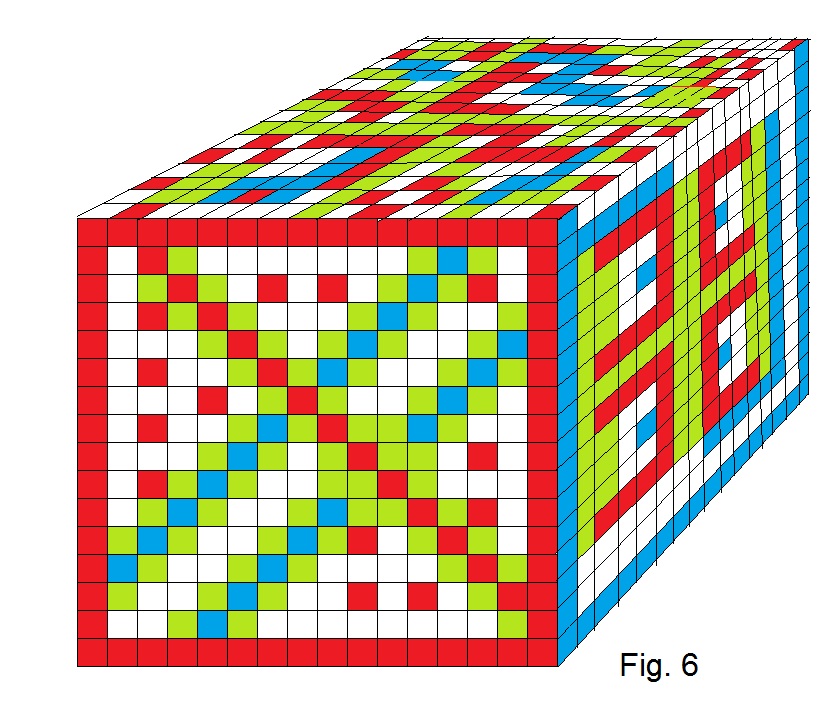
Celluar Automata-Based Evolving Self-Controlled Light Pattern Generation on LED Canvas
Charles Kim
Click images for video clips. In case of video play problem, like freeze while playing, try "Save Page As" and play in your computer).
In every side of us, optical technology and
lighting industry are increasingly revolving around light emitting diodes (LEDs)
replacing the traditional light bulbs in general lighting, energy-saving
applications, and architectural and entertainment sectors.
The wide-spread use of LEDs in beautifying
buildings and streets and parks and skylines has fascinated people around the
globe.
The focus of this LED
application is about drawing evolving patterns in each
discrete time step with lights on a canvas of LEDs.
The drawing mechanism is not done by the
conventional light control method, which, using a central computer with control
wires connecting each of the lamps in an array of lamps, controls each every
lamp to produce a desired pattern in the array.
Instead, the drawing on the canvas is,
ironically, a by-product of the collective, synchronous action of each
individual LED which does nothing but select its color, determined using a very
simple rule, for the next discrete time step, by the present states of its
neighboring LEDs.
In analogy, the resulting pattern on the LED
canvas resembles the global manifestation of all local activities whose
governing rules are the same, or a complex system built from simple components.
This autonomous, self-control of each LED by
its neighboring conditions in an LED array is based on a mathematical algorithm
called cellular automata, a discrete mathematical modeling basis.
Cellular automata are an
alternative, complementary basis for mathematical models of system to
differential equations which are generally suitable for systems with a small
number of continuous degrees of freedom, evolving in a continuous manner.
Cellular
automata describe the behaviors of systems with large numbers of discrete
degrees of freedom.
Put another way, cellular automata represent a
mathematical idealization of physical systems in which space and time are
discrete, and physical quantities take on a finite set of discrete values.
More specifically, cellular
automata consist of a discrete lattice ("array") of sites ("cells"). Each site
takes in a finite set of possible values and the value of each site evolves, in
discrete time steps, simultaneously, according to the same deterministic rules.
The rules for the evolution of a site depend only on a local neighborhood of
sites around it.
Because of these advantages, cellular automata
have been applied in biological systems to model growth of organisms or
populations of plant with local ecological interaction.
The idea of self-change of LED color by the states (i.e., colors) of its neighbors eliminates the need of a central processor and control wires from the central processor to each of the LEDs in the array. To be used in the light canvas and thus utilized in the cellular automata scheme of color change, traditional LED fixture should be additionally equipped with a low-end microprocessor, as illustrated in the Figures 1 and 2, to execute a cellular automat rule for determining its color state for the next time step, and a number of color sensors to read the current time color states of the neighboring LEDs.



One example of a rule, in an
array of 8-neighbor configuration illustrated in Figure 4, simultaneously
applying to each of the LEDs, is “If 2 neighbors out of 8 are in RED color in
the current time step, then the color of the self in the next time step is RED."
Another example of a rule is: "If the left
neighbor LED's color is RED and the right neighbor LED's status is BLUE in the
current time step, and the current color of self is RED, then the self’s color
in the next time step is GREEN."
An example light pattern simulated using a
simple rule is depicted in Figure 5.
The effect of the same rule for
all LEDs, seemingly simple and dull, can generate in the array level very
beautiful natural light patterns on the light canvas.
A future plan of expanding this LED
canvas idea is to make a cube (see
Figure 6), with a light canvas on all sides except the bottom which will house a
stand and base to hold the cube.
Each side will be run on the selected rules of
cellular automata, and the patterns corresponding to the rules on its respective
light canvas will be generated independently.
Therefore, the beautiful light patterns of the
cube can be observed and appreciated at all sides and above.
Moreover, I plan to install a Bluetooth-
and Power Line Carrier-capable controller with
a display at each side so that it can, first, receive observers’ rule numbers
sent from their smartphones and, second, it send the rules to the each of the
LED modules on the light canvas.
By this interaction of observers and the LED
canvas cube, it can provide more engaging experience with lighting technology,
smartphones, and lighting with LEDs.
